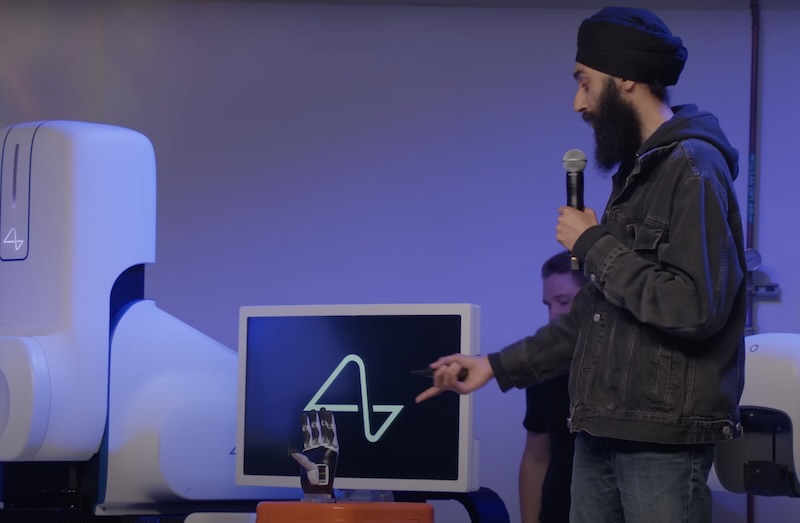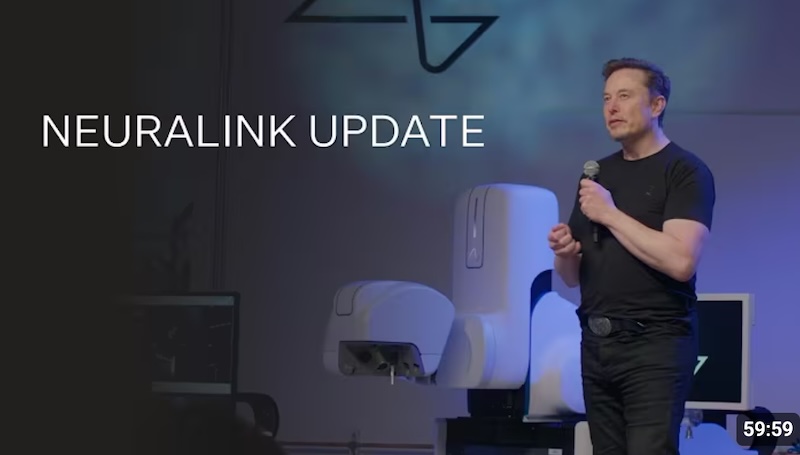Neuralink’s latest demonstration marked a turning point in brain-computer interface technology, showcasing capabilities that blur the line between human intention and machine execution. Neuralink’s weekend hour-long presentation revealed not just incremental progress, but a glimpse into a future where thoughts translate directly into digital and physical actions.
Alex, the company’s second human trial participant, initiated what appeared to be a simple countdown sequence. However, the execution method proved extraordinary — a robotic hand responded to Alex’s neural signals, counting down from five to one without any external control mechanisms. Engineers subsequently confirmed the appendage belonged to a Tesla Optimus robot, responding in real-time to motor cortex signals transmitted through Neuralink’s brain interface system.

A Tesla Optimus Hand responded to Alex’s neural signals
Neuralink’s broader vision of creating seamless communication pathways between human consciousness and digital infrastructure.
Current human output capabilities present significant constraints for brain-computer interaction. Elon highlighted this fundamental bottleneck during the presentation, noting that human output bandwidth operates at less than one bit per second through traditional methods like typing or speaking.
Neuralink’s ambitious target involves increasing this rate to one million bits per second initially, with eventual goals reaching one billion bits per second. While human input bandwidth benefits from visual processing capabilities, the company believes even these can be enhanced to gigabit levels.
The implications extend beyond mere speed improvements. Enhanced bandwidth could fundamentally alter how humans interact with technology, potentially eliminating the friction between thought and digital execution that currently defines our relationship with computers.
Neuralink’s first commercial product, Telepathy, targets individuals with severe paralysis by enabling direct mental control of computer interfaces. Users can navigate cursors, execute clicks, and type text with precision that matches or potentially exceeds healthy motor function.
Current deployment statistics reveal the product’s practical viability. Seven individuals now use Telepathy regularly, with usage patterns averaging 50 hours weekly—some participants exceed 100 hours, essentially utilizing the system during all waking moments.
Implementation timelines have accelerated dramatically. Interval between the first and second users spanned six months, while the gap between the sixth and seventh users reduced to just one week. Acceleration suggests both improved surgical procedures and enhanced system reliability.
The user base continues expanding across multiple countries, including the US, UK, Canada, and UAE.
Neuralink’s second product, Blindsight, addresses visual impairment through direct neural stimulation of the visual cortex. System aims to restore sight for individuals with blindness, including those born without vision.
Initial resolution capabilities will be limited, but the company projects dramatic improvements over time. Won’t simply replicate normal human vision—it’s designed to extend beyond natural capabilities, potentially incorporating infrared and ultraviolet spectrum detection.
The Blindsight system utilizes specialized glasses equipped with embedded cameras that capture visual information and transmit data directly to electrodes positioned in the visual cortex. Approach bypasses damaged or absent optical pathways entirely, creating new routes for visual information processing.
Neuralink’s development timeline outlines specific milestones for electrode count increases and brain region expansion. Current Telepathy implementations utilize 1k electrodes focused on motor cortex regions.
Next quarter’s objectives include speech cortex implantation, enabling direct conversion of neural activity into spoken words. Advancement would eliminate the intermediary step of typing, allowing thoughts to transform directly into verbal communication.
2026 targets include tripling electrode count to 3k and implementing the first Blindsight installation in a blind user. Following year, 2027, aims for 10k electrodes with multiple implant sites across different brain regions—motor, speech, and visual areas simultaneously.
By 2028, plans call for over 25k electrodes with multi-channel access capabilities spanning any brain region. Expansion enables treatment for depression, chronic pain, movement disorders, and potentially direct AI integration.
Cost reductions and process improvements have transformed Neuralink’s manufacturing capabilities. Original needle production costs reached $350 per unit with 24-hour manufacturing cycles. Current generation tools have reduced this to $15 per needle with 30-minute production times.
The company’s new surgical robot addresses previous limitations. Earlier R1 robot installations required 17 seconds per wire with frequent failures due to external interference. Updated system completes wire placement in 1.5 seconds and achieves over 99% compatibility across human brain variations, with insertion depths reaching 50 millimeters.
Advanced brain scanning partnerships with Siemens have produced next-generation brain mapping capabilities. Over 50 volunteers participated in scanning procedures to create surgical guidance systems for the enhanced precision required by visual cortex implantation.
Future applications extend beyond individual computer control. Users may eventually operate entire robotic bodies, effectively providing paralyzed individuals with complete physical mobility through Optimus robots. Amputees could gain fully functional robotic limbs controlled through neural interfaces.
The proximity between brain regions creates additional opportunities. Speech centers located inches below motor cortex areas mean existing surgical robots, software, and hardware can adapt for mind-to-speech applications without requiring separate procedures.
Convergence of brain regions and technology platforms suggests Neuralink’s approach could address multiple conditions simultaneously through single surgical interventions.
Brain-computer interfaces aren’t just rewiring human capabilities—they’re fundamentally re-linking how we perceive the boundaries between mind and machine.
Related Post
Neuralink Implants Telepathy Chip in 6th Patient, Enables Mind-Controlled Computing
Neuralink Second Patient It’s 400 Electrodes this Time? Vs 1024 last time
Neuralink’s ‘Blindsight’ Implant Restoring Vision in Monkeys, Humans Next
